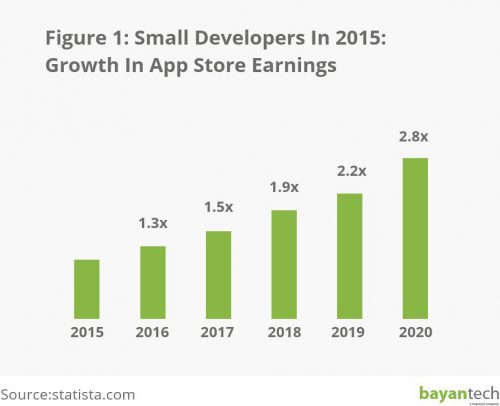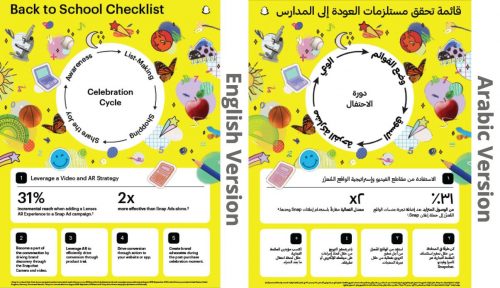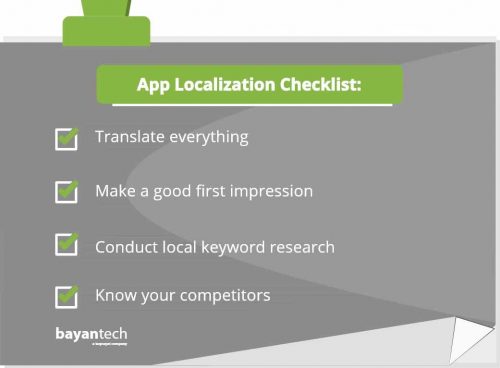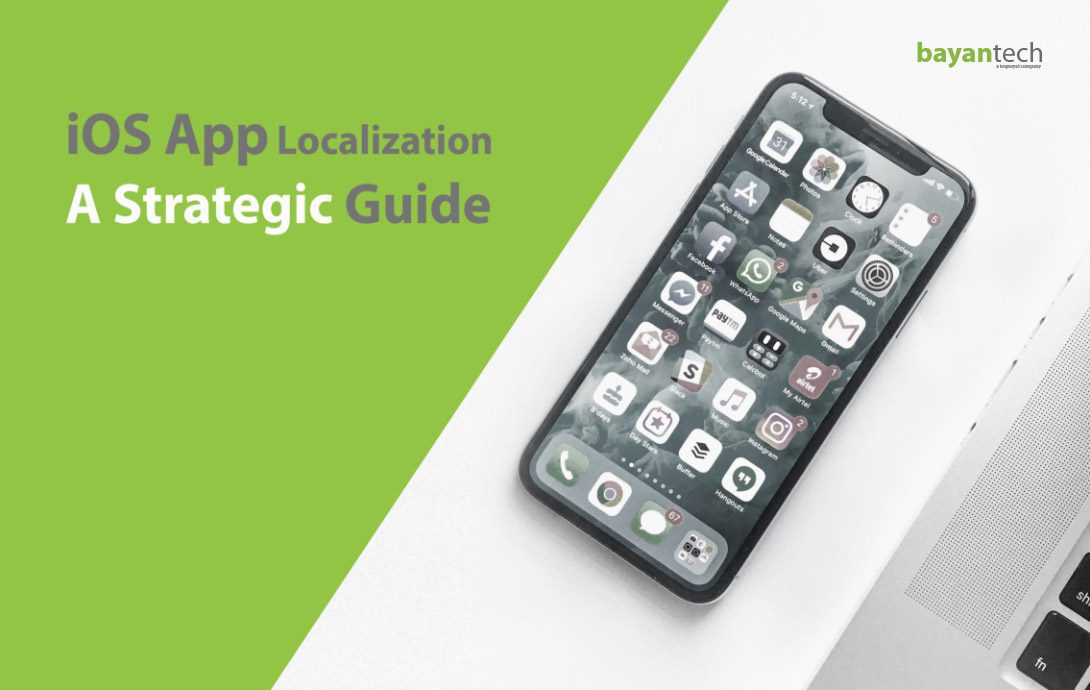iOS apps, and mobile apps in general, are developed with growth in mind. That’s the purpose – and the expectation. Limiting the audience of your app means limiting the growth of your app. It’s why growth is deeply linked to how well your app is adapted to meet the needs of “different” audiences around the globe. A process that goes by the name iOS App Localization.
However, localization is not just a linguistic process. It unfolds across cultural, technical, and functional business domains. It involves working with the user interface’s structure and its visual content, as much as with language to enhance UX and achieve an immersive, convenient and high-end outcome.
In this post, we’ll take a look at the iOS app localization process and share some expert advice. But, let’s start at the beginning: Why should you localize your iOS app?

Why You Should Localize your iOS App
According to a 2021 report by Apple, the company paid developers over $39 billion in App Store revenue in 2019. If you consider indirect revenue (in-app sales, digital advertising, etcetera) as well, the numbers increase significantly. Apple estimates that “the App Store ecosystem facilitated $643 billion in billings and sales worldwide in 2020”.

The iOS app store may sound like a land of opportunities. But it’s worth highlighting that it’s a hypercompetitive platform, and app developers often have to implement a 360°, an omnichannel platform to succeed, from app store optimization, localization, and cross-cultural SEO to influencer marketing.
However, if your app already has a well-established app store presence, you might have noticed some foreign attention. International users might be looking at your app as the unique solution to a specific problem, a solid alternative to a more widely popular tool, or simply as a great past-time. And, you might be considering targeting foreign markets as a growth opportunity.
With millions of users from all around the world using Apple Devices (and the Apple App Store), adapting your app to certain foreign audiences’ cultural and technical needs via iOS app localization is simply a smart move. In the next section, we’ll dive a little deeper into how to get started.
Localizing your iOS App, Step-by-Step
The first step of the iOS app localization process has nothing to do with language or code, and everything to do with market research.
Research
Start out by understanding where your app stands in your home market and detecting opportunities to expand to foreign locales. Localization is about adapting a product so it feels native to the new target market. So, you can’t localize without a specific target locale in mind.
For instance, let’s say your app is getting some social media attention and a good amount of downloads and conversions among Italian users. In that case, you should be targeting the Italian market. If you can’t find a similar pattern among your existing userbase, refocus your research around the need your game serves and existing alternatives. Look for an international market where your app can succeed, and structure your plan accordingly.
Signs that a market is receptive to your app
- Social media attention. Foreign users are talking about your app.
- A high number of downloads from users in that locale.
- A hole in the market. There's no popular or high-performing alternative to your app, but the need for it is there.
- Existing demand, but deeply flawed options. You already have competitors in that market, but they fail where your app excels.
As a general rule, you should start by looking at markets that are geographically and culturally close to you. That way, you’ll only have to perform some basic cross-cultural adaptation. You’ll also be facing less risk while getting a chance to establish internal processes and partnerships that will allow you to expand further.
Base Internationalization
Once you know which market you’ll target, it’s time to get to work. We want to make this overview as accessible as possible for non-technical founders and stakeholders. Consequently, we won’t dive into code. We’ll also assume that your technical team is using the most common stack for iOS app development: Swift and XCode.
Before you can start your iOS app localization, you’ll need to perform internationalization. Internationalization and localization go hand-in-hand. Internationalization is the procedure of adapting your app so it can serve as a solid foundation to create various culture-specific versions.
If you’re using Swift and XCode, you’ll be able to find a Base file within your project folder, which will include strings in your base language. If your content is on storyboard files, you’ll need to decouple it from your code to be able to work with it.
Translate your Strings
The next step consists of using the XCode interface to translate your content into your target language (or even into multiple languages).
Chances are your app development team isn’t bilingual. For this step (and, in most cases, for the steps before and after it), you will want to partner up with an expert app localization company.
A language services provider that specializes in iOS app localization will be able to perform the technical, linguistic, and cultural aspects of localization, and deliver strategic results. Relying on a third party for iOS app localization spares you of having to manage the project, source the necessary language talent, and perform QA and other important processes.
Especially if it’s your first time considering iOS app localization as the key to growth, you might be wondering if you can cut corners on translation. This would be far from ideal.
According to industry research, approximately 70% of users churn within 90 days. Apps are easy to download and easy to delete. And with virtually thousands of potential options, users have very high standards. A poorly translated message, unclear instructions, or culturally insensitive statements can motivate users to distance themselves from your product, leave a bad App Store review, and, needless to say, never convert. A great concept, properly executed, and flawlessly adapted to local needs can cause the exact opposite: great reviews, a loyal user base, and a high conversion rate.

Adapt Audiovisual Content, Dates and Currency, Etcetera
Once your content is properly translated and adapted, you’ll need to adapt the audiovisual material in your app, date forming, currency formatting, and other elements.
XCode makes it extremely easy to adapt visual content. For instance, you can replace an image on one of your storyboards simply by dragging it into the program and working with the visual interface. Thanks to xCode you can manage all the aspects of your app development in one place, its file inspector will centralize your english text, localized strings, localized text and multimedia content and strings file, all in one user-friendly interface.
This step, and the steps before translating the text strings are what truly sets translation and localization apart. Localization is a holistic process, while translation is hyper-focused on rendering a message into another language.
This step’s greatest challenge has to do with knowing what to adapt, and to what end. This requires deep cross-cultural understanding and strategic insight, as well as app development skills.

Now that we have a general idea of how iOS localization usually goes, let’s take a look at some strategic considerations you should have in mind.
These considerations include:
- How cultural differences shape your iOS app localization.
- How market differences affect your localization.
- How the app will be marketed.

iOS Localization & Cultural Differences
It’s worth bringing attention to the fact that your target locale will determine whether you’ll have to perform in-depth app localization, or just translate your content, integrate it to your interface, and perform some testing and quality assurance.
For instance, if you find that your American app could be a great fit for an Arabic-speaking market, you’ll probably have to completely reimagine your messaging and interface.
Among other changes, you’ll have to:
- Mirror certain UI elements.
- Change customer representations.
Sign up to our newsletter to receive the latest blogs and news.
Meanwhile, if you’re planning to translate your UK-based app to the French market, you won’t have to
How Market Differences Affect iOS App Localization
Aside from culture, general market conditions (such as the presence or absence of certain products) can affect your iOS localization.
For example, if your app is actually the mobile version of an online store, you’ll need to make sure the payment gateways you’ll be offering in your localized version are available in your target locale.
Beyond iOS App Localization

A localized app is not enough. If you’re working to expand your app’s user base beyond your home market, you’ll need to localize everything that surrounds it as a product. For instance, if you want to make it findable on the app store at a global scale, you’ll need to create a new, localized listing that matches the application language, while targeting locally relevant keywords.
Are you in need of iOS App Localization Services? We’ll tell you everything you need to know
Download this quick guide for free
Key Takeaways
iOS app localization involves a combination of linguistic, cultural, and technical expertise. While iOS development’s most common stack simplifies localization, there are some aspects of the process that are best delegated to an expert third party, especially translation and the cross-cultural adaptation of audiovisual material and messaging.
Other functional aspects, such as integrations, should also be taken into account for a competitive UX that converts curious users into loyal customers.
Partner up with an Expert
The plan to go global might seem overwhelming, technically complex, and strategically demanding. But you don’t have to do it alone.
At bayantech, we gather two decades of experience providing translation services and localization solutions to industry leaders in the MENA region, as well as internationally.
With a commitment to software localization best practices, a multidisciplinary team of experts, and bulletproof processes, we uphold the highest standard in app localization services and more.
Get in touch today and seize new business opportunities on an international scale.
Expand to new markets







